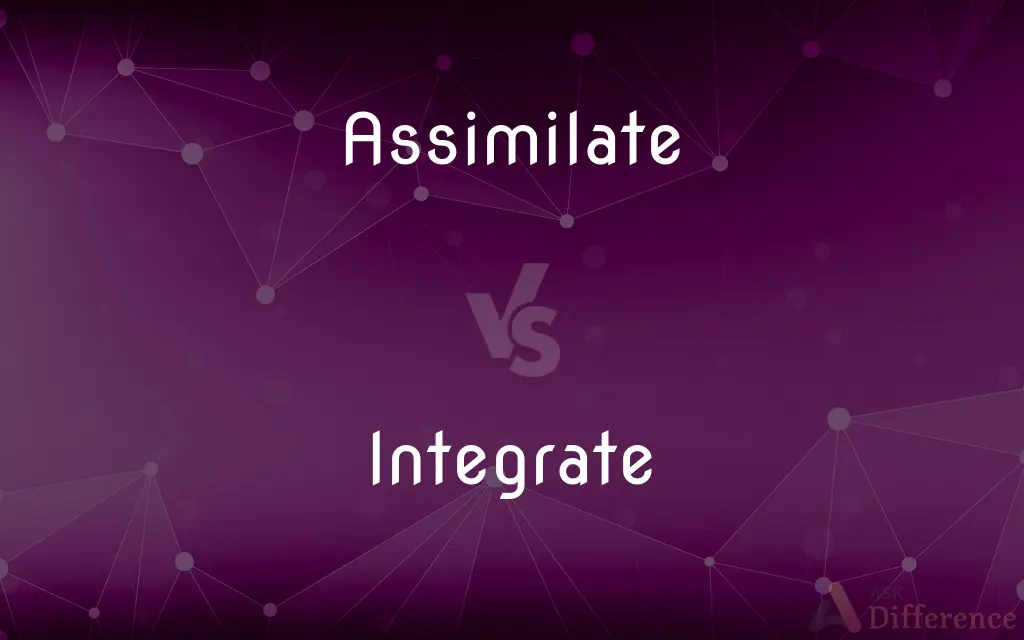Assimilate vs. Integrate — What's the Difference?
By Urooj Arif & Fiza Rafique — Updated on March 30, 2024
Assimilate involves absorbing and fully understanding information or ideas, or culturally adopting the ways of another group, while integrate involves combining parts into a whole, emphasizing inclusion and diversity in society or systems.

Difference Between Assimilate and Integrate
Table of Contents
ADVERTISEMENT
Key Differences
Assimilation often refers to the process by which an individual or group adopts the culture, customs, and attitudes of another group, losing their original identity in the process. This can occur within social, cultural, or educational contexts, where the goal is to become indistinguishable from the dominant group. Integration, on the other hand, focuses on bringing diverse elements together into a cohesive whole without necessitating the loss of individual identities. It emphasizes equality and coexistence within a diverse society or system.
While assimilation can lead to a homogeneous society where differences are minimized or erased, integration promotes diversity and the value of having varied perspectives and backgrounds coexisting. In education or work environments, assimilation might mean adopting the prevailing methods and attitudes completely, whereas integration suggests creating an environment where various methods and attitudes are valued and contribute to the overall goals.
In terms of policy and practice, assimilationist policies might encourage or force minority groups to adopt the majority's culture, potentially at the expense of their own cultural heritage. Integrative policies, however, seek to ensure equal participation and representation of all groups within the societal framework, recognizing and valuing differences.
The debate between assimilation and integration is significant in immigration, education, and organizational culture, reflecting different approaches to dealing with diversity. Assimilation might simplify cultural interactions but at the cost of cultural diversity, while integration seeks to balance unity with preserving individual cultural identities.
While both processes aim to adjust or combine different elements, the key difference lies in the approach to and the outcome of these adjustments. Assimilation might result in a singular, unified culture, whereas integration aims for a pluralistic society where differences are not just acknowledged but celebrated.
ADVERTISEMENT
Comparison Chart
Objective
To absorb and adopt the characteristics of another
To combine parts into a cohesive whole
Focus
Cultural adoption and uniformity
Inclusion and diversity
Outcome
Homogeneity, loss of original identity
Coexistence of diverse elements without losing identity
Application
Cultural, social, educational contexts
Social, educational, organizational contexts
Policy Implication
Encourages or forces adoption of a dominant culture
Promotes equality and representation of diversity
Compare with Definitions
Assimilate
To fully absorb and adopt another culture.
Immigrants often feel pressure to assimilate into the mainstream culture.
Integrate
Promotes diversity and inclusion.
Their policy is to integrate diverse voices into the decision-making process.
Assimilate
Emphasizes conformity and uniformity.
The company's culture encourages new employees to assimilate quickly.
Integrate
To combine parts into a cohesive whole while maintaining individuality.
The school aims to integrate children from various backgrounds.
Assimilate
Often used in the context of absorbing information.
He assimilated the feedback from his review and improved.
Integrate
Balances unity with preserving differences.
The community worked to integrate without losing cultural identities.
Assimilate
To fully understand and incorporate new ideas.
She quickly assimilated the new information from the training.
Integrate
In technology, to make systems work together seamlessly.
We need to integrate the new software with our existing systems.
Assimilate
Can lead to loss of original identity or culture.
Their traditions began to fade as they assimilated.
Integrate
Applies to ensuring equal participation in society.
Laws were enacted to integrate minority groups into all sectors of society.
Assimilate
To consume and incorporate (nutrients) into the body after digestion.
Integrate
Combine (one thing) with another to form a whole
A fully equipped laboratory is being integrated into the development
Transport planning should be integrated with energy policy
Assimilate
To transform (food) into living tissue by the process of anabolism; metabolize constructively.
Integrate
Bring (people or groups with particular characteristics or needs) into equal participation in or membership of a social group or institution
Integrating children with special needs into ordinary schools
Assimilate
To incorporate and absorb into the mind
Assimilate knowledge.
Integrate
Find the integral of
The velocity profile can be obtained by integrating this equation
Assimilate
To make similar; cause to resemble.
Integrate
To make into a whole by bringing all parts together; unify
A report that integrates the findings of previous studies.
Assimilate
(Linguistics) To alter (a sound) by assimilation.
Integrate
To join with something else; unite
A music program that was integrated with the general curriculum.
Assimilate
To absorb (immigrants or a culturally distinct group) into the prevailing culture.
Integrate
To make part of a larger unit
Integrated the new procedures into the work routine.
Assimilate
To become assimilated.
Integrate
To open (an institution, for example) to people of all races or ethnic groups without restriction; desegregate.
Assimilate
(transitive) To incorporate nutrients into the body, especially after digestion.
Food is assimilated and converted into organic tissue.
Integrate
To admit (a racial or ethnic group) to equal membership in an institution or society.
Assimilate
(transitive) To incorporate or absorb (knowledge) into the mind.
The teacher paused in her lecture to allow the students to assimilate what she had said.
Integrate
To calculate the integral of.
Assimilate
(transitive) To absorb (a person or people) into a community or culture.
The aliens in the science-fiction film wanted to assimilate human beings into their own race.
Integrate
To perform integration on.
Assimilate
To liken, compare to something similar.
Integrate
(Psychology) To bring about the integration of (personality traits).
Assimilate
(transitive) To bring to a likeness or to conformity; to cause a resemblance between.
Integrate
To become integrated or undergo integration.
Assimilate
(intransitive) To become similar.
Integrate
To form into one whole; to make entire; to complete; to renew; to restore; to perfect.
Assimilate
(intransitive) To be incorporated or absorbed into something.
Integrate
To include as a constituent part or functionality.
They were keen to integrate their new skills into the performance.
Assimilate
Something that is or has been assimilated.
Integrate
To indicate the whole of; to give the sum or total of; as, an integrating anemometer, one that indicates or registers the entire action of the wind in a given time.
Assimilate
To bring to a likeness or to conformity; to cause a resemblance between.
To assimilate our law to the law of Scotland.
Fast falls a fleecy; the downy flakesAssimilate all objects.
Integrate
(mathematics) To subject to the operation of integration; to find the integral of an equation.
Assimilate
To liken; to compa e.
Integrate
To desegregate, as a school or neighborhood.
The refugees were well integrated into the community.
Assimilate
To appropriate and transform or incorporate into the substance of the assimilating body; to absorb or appropriate, as nourishment; as, food is assimilated and converted into organic tissue.
Hence also animals and vegetables may assimilate their nourishment.
His mind had no power to assimilate the lessons.
Integrate
(genetics) To combine compatible elements in order to incorporate them.
Assimilate
To become similar or like something else.
Integrate
To form into one whole; to make entire; to complete; to renew; to restore; to perfect.
Two distinct substances, the soul and body, go to compound and integrate the man.
Assimilate
To be converted into the substance of the assimilating body; to become incorporated; as, some kinds of food assimilate more readily than others.
I am a foreign material, and cannot assimilate with the church of England.
Integrate
To indicate the whole of; to give the sum or total of; as, an integrating anemometer, one that indicates or registers the entire action of the wind in a given time.
Assimilate
Take up mentally;
He absorbed the knowledge or beliefs of his tribe
Integrate
To subject to the operation of integration; to find the integral of.
Assimilate
Become similar to one's environment;
Immigrants often want to assimilate quickly
Integrate
Make into a whole or make part of a whole;
She incorporated his suggestions into her proposal
Assimilate
Make similar;
This country assimilates immigrants very quickly
Integrate
Open (a place) to members of all races and ethnic groups;
This school is completely desegregated
Assimilate
Take (gas, light or heat) into a solution
Integrate
Become one; become integrated;
The students at this school integrate immediately, despite their different backgrounds
Assimilate
Become similar in sound;
The nasal assimialates to the following consonant
Integrate
Calculate the integral of; calculate by integration
Common Curiosities
What is a key benefit of integration over assimilation?
Integration allows for a richer, more diverse society that values multiple perspectives and cultures, enhancing creativity and innovation.
Can a society pursue both assimilation and integration?
While theoretically possible, in practice, emphasizing one often diminishes the focus or effectiveness of the other.
Can assimilation occur without pressure or force?
Yes, individuals may voluntarily assimilate into another culture, often for social acceptance or opportunities.
Does assimilation have any positive aspects?
It can facilitate understanding and communication within a society by creating a common cultural ground, but this often comes at the cost of cultural diversity.
Is integration always a smooth process?
No, integration can face challenges such as resistance to change or the maintenance of systemic barriers.
How do assimilation and integration differ in educational settings?
Assimilation in education might mean adopting the dominant culture's learning styles, while integration would involve valuing diverse educational backgrounds and methods.
Can integration lead to a loss of cultural identity?
When properly managed, integration allows for the maintenance of cultural identities within a cohesive society, unlike assimilation, which often leads to a loss of identity.
How do policies support integration?
Policies support integration by promoting equal opportunities, preventing discrimination, and encouraging the representation of diverse groups in all aspects of society.
What role does language play in assimilation and integration?
Language is a key aspect; assimilation often requires adopting the dominant language, while integration seeks to value and preserve multiple languages.
What challenges do organizations face in integrating diverse teams?
Challenges include overcoming biases, communication barriers, and creating an inclusive culture that values diversity.
Is assimilation easier than integration for individuals?
Assimilation might seem easier in the short term for individuals seeking immediate acceptance, but it can lead to long-term issues of identity loss and cultural erosion.
How does globalization impact assimilation and integration?
Globalization has complex effects, simultaneously promoting assimilation through cultural homogenization and integration through increased awareness of and respect for diversity.
Why is integration considered more sustainable than assimilation?
Integration's emphasis on diversity and inclusion makes it more adaptable to changing demographics and societal needs.
How do immigrants face assimilation and integration?
Immigrants often navigate between the pressure to assimilate for social cohesion and the desire to integrate while maintaining their cultural identity.
What are the signs of successful integration in a community?
Indicators include diverse representation in leadership roles, equal access to opportunities, and mutual respect for cultural differences.
Share Your Discovery

Previous Comparison
Facsimile vs. Replica
Next Comparison
Fettling vs. GrindingAuthor Spotlight
Written by
Urooj ArifUrooj is a skilled content writer at Ask Difference, known for her exceptional ability to simplify complex topics into engaging and informative content. With a passion for research and a flair for clear, concise writing, she consistently delivers articles that resonate with our diverse audience.
Co-written by
Fiza RafiqueFiza Rafique is a skilled content writer at AskDifference.com, where she meticulously refines and enhances written pieces. Drawing from her vast editorial expertise, Fiza ensures clarity, accuracy, and precision in every article. Passionate about language, she continually seeks to elevate the quality of content for readers worldwide.














































